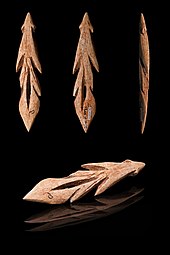Gae Bolga

Gae Bolga [ gai 'bolga ] ("spear of agony"?, "Notched spear"?), Also Gáe Bolga , Gáe Bulga , Gáe Bulg or Gáe Bolg , is the mysterious harpoon weapon of Cú Chulainn in Irish mythology . The name is made up of the developed Celtic word * gaiso - / * gēso- ("spear"; Old Irish gae , Kymrian gwayw ), and Celtic * bolga- ("[leather] sack", "belly", "bellows") ; Old Irish bolg , Cymrian bol ). This indicates a harpoon with an air-filled animal bladder, similar to the hunting weapon used by the Eskimo .
mythology
According to tradition, the Gae Bolga is said to have been carved from the bone of a sea monster. He was given to Cú Chulainn by the Scottish warrior queen Scáthach at the end of his training. This spear can only be used under water, whereby it had to be wedged between the big and second toe and thrown upwards. It penetrated the opponent's body, opening the barbs and tearing incurable wounds in the intestines.
With the Gae Bolga, Cú Chulainn killed his foster brother Fer Diad , the son of Fergus mac Róich, and in the saga Aided Oenfir Aífe (“The Death of Aoifes. ”) According to the tale Táin Bó Cuailnge (“The cattle robbery of Cooley ”) in a duel at the ford only son ”) in a duel on the seashore his son Connla , whom he had fathered with Scathach's sister Aoife .
Specially designed spearheads have often been archaeologically proven among the Celts, for example the Lusitanians had barbed spearheads , in mythology the god Midir carried a lance with several points and in Gododdin the four-pointed pedryollt are mentioned.
See also
literature
- Helmut Birkhan : Celts. Attempt at a complete representation of their culture. Publishing house of the Austrian Academy of Sciences, Vienna 1997, ISBN 3-7001-2609-3 .
- Bernhard Maier : Lexicon of Celtic Religion and Culture (= Kröner's pocket edition . Volume 466). Kröner, Stuttgart 1994, ISBN 3-520-46601-5 .
- Bernhard Maier: Small lexicon of names and words of Celtic origin. CH Beck OHG, Munich 2003, ISBN 3-406-49470-6 .
- Ingeborg Clarus : Celtic Myths. Man and his otherworld. Walter Verlag 1991, ppb edition Patmos Verlag, Düsseldorf, 2000, 2nd edition, ISBN 3-491-69109-5 .
Individual evidence
- ↑ Bernhard Maier: Small lexicon of names and words of Celtic origin. Pp. 103 f., 111.
- ↑ Helmut Birkhan: Nachantike Keltenrezeption. Praesens Verlag, Vienna 2009, ISBN 978-3-7069-0541-1 , p. 526, note 4.
- ↑ Helmut Birkhan: Celts. Attempt at a complete representation of their culture. Publishing house of the Austrian Academy of Sciences, Vienna 1997, ISBN 3-7001-2609-3 , p. 959.
- ^ Ingeborg Clarus: Celtic myths. Man and his otherworld. Walter Verlag 1991, ppb edition Patmos Verlag, Düsseldorf, 2000, 2nd edition, ISBN 3-491-69109-5 , pp. 151, 165.
- ↑ Helmut Birkhan: Celts. Attempt at a complete representation of their culture. P. 1136.
